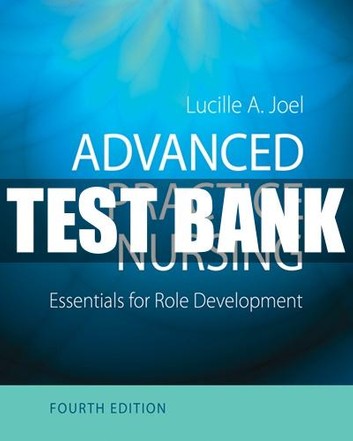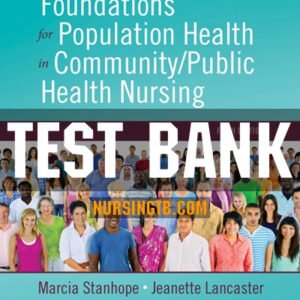Test Bank for Advanced Practice Nursing: Essentials for Role Development 4th Edition Joel
$35
Description
Test Bank for Advanced Practice Nursing: Essentials for Role Development 4th Edition Joel Test Bank
You will receive this product immediate after placing the order
Table of Contents
I. The Evolution of Advanced Practice
1. Advanced Practice Nursing: Doing What Has to Be Done-Radicals, Renegades, and Rebels (Lynne M. Dunphy)
2. Emerging Roles of the Advanced Practice Nurse (Deborah Becker & Caroline Doherty)
3. Role Development: A Theoretical Perspective (Lucille A. Joel)
4. Educational Preparation of Advanced Practice Nurses: Looking to the Future (Phyllis Shanley Hansell)
5. Global Perspectives on Advanced Nursing Practice by (Madrean Schober & Anna Green)
II. The Practice Environment
6. Advanced Practice Nurses and Prescriptive Authority (Jan Towers)
7. Credentialing and Clinical Privileges for the Advanced Practice Registered Nurse (Ann Carey & Mary Smolenski)
8. The Kaleidoscope of Collaborative Practice (Alice F. Kuehn)
9. Participation of the Advanced Practice Nurse in Health Plans and Quality Initiatives (Rita Munley Gallagher)
10. Public Policy and the Advanced Practice Registered Nurse (Marie Eileen Onieal)
11. Resource Management (Eileen D. Flaherty, Antigone Grasso, & Cindy Aiena)
12. Mediated Roles: Working With and Through Other People by (Thomas D. Smith, Maria L. Vezina, Mary E. Samost, & Kelly Reilly)
III. Competency in Advanced Practice
13. Evidence-Based Practice (Deborah C. Messecar & Christine A. Tanner)
14. Advocacy and the Advanced Practice Nurse (Andrea Brassard)
15. Case Management and Advanced Practice Nursing (Denise Fessler & Irene McEachen)
16. The Advanced Practice Nurse and Research (Beth Quatrara and Dale Shaw)
17. The Advanced Practice Nurse: Holism and Complementary and Integrative Health Approaches (Carole Ann Drick)
18. Basic Skills for Teaching and the Advanced Practice Nurse (Valerie Sabol, Benjamin A. Smallheer, & Marilyn H. Oermann)
19. Culture as a Variable in Practice (Mary Masterson Germain)
20. Conflict Resolution in Advanced Practice Nursing (David M. Price & Patricia Murphy)
21. Leadership for APNs: If Not Now, When? (Edna Cadmus)
22. Information Technology and the Advanced Practice Nurse by (Robert Scoloveno)
23. Writing for Publication (Shirley Smoyak)
IV. Ethical, Legal and Business Acumen
24. Measuring Advanced Practice Nurse Performance: Outcome Indicators, Models of Evaluation and the Issue of Value (Shirley Girouard, Patricia DiFusco, and Joseph Jennas)
25. Advanced Practice Registered Nurses: Accomplishments, Trends, and Future Development (Jane M. Flanagan, Allyssa Harris, & Dorothy A. Jones)
26. Starting a Practice and Practice Management (Judith Barberio)
27. The Advanced Practice Nurse as Employee or Independent Contractor: Legal and Contractual Considerations (Kathleen M. Gialanella)
28. The Law, The Courts, and the Advanced Practice Registered Nurse (David M. Keepnews)
29. Malpractice and the Advanced Practice Nurse (Carolyn T. Torres)
30. Ethics and the Advanced Practice Nurse (Gladys L. Husted, James H. Husted, & Carrie Scotto)
Chapter 1 . Advanced Practice Nursing: Doing What Has to Be Done-Radicals, Renegades, and Rebels
MULTIPLE CHOICE
1. The nurse manager of a pediatric clinic could confirm that the new nurse recognized the purpose of the HEADSS Adolescent Risk Profile when the new nurse responds that it is used to assess for needs related to
a. anticipatory guidance.
b. low-risk adolescents.
c. physical development.
d. sexual development.
ANS: A
The HEADSS Adolescent Risk Profile is a psychosocial assessment screening tool which assesses home, education, activities, drugs, sex, and suicide for the purpose of identifying high-risk adolescents and the need for anticipatory guidance. It is used to identify high-risk, not low-risk, adolescents. Physical development is assessed with anthropometric data. Sexual development is assessed using physical examination.
REF: 6 OBJ: NCLEX Client Needs Category: Health Promotion and Maintenance
2. The nurse preparing a teaching plan for a preschooler knows that, according to Piaget, the expected stage of development for a preschooler is
a. concrete operational.
b. formal operational.
c. preoperational.
d. sensorimotor.
ANS: C
The expected stage of development for a preschooler (3 to 4 years old) is preoperational. Concrete operational describes the thinking of a school-age child (7 to 11 years old). Formal operational describes the thinking of an individual after about 11 years of age. Sensorimotor describes the earliest pattern of thinking from birth to 2 years old.
REF: 5 OBJ: NCLEX Client Needs Category: Health Promotion and Maintenance
3. The school nurse talking with a high school class about the difference between growth and development would best describe growth as
a. processes by which early cells specialize.
b. psychosocial and cognitive changes.
c. qualitative changes associated with aging.
d. quantitative changes in size or weight.
ANS: D
Growth is a quantitative change in which an increase in cell number and size results in an increase in overall size or weight of the body or any of its parts. The processes by which early cells specialize are referred to as differentiation. Psychosocial and cognitive changes are referred to as development. Qualitative changes associated with aging are referred to as maturation.
REF: 2 OBJ: NCLEX Client Needs Category: Health Promotion and Maintenance
4. The most appropriate response of the nurse when a mother asks what the Denver II does is that it
a. can diagnose developmental disabilities.
b. identifies a need for physical therapy.
c. is a developmental screening tool.
d. provides a framework for health teaching.
ANS: C
The Denver II is the most commonly used measure of developmental status used by health care professionals; it is a screening tool. Screening tools do not provide a diagnosis. Diagnosis requires a thorough neurodevelopment history and physical examination. Developmental delay, which is suggested by screening, is a symptom, not a diagnosis. The need for any therapy would be identified with a comprehensive evaluation, not a screening tool. Some providers use the Denver II as a framework for teaching about expected development, but this is not the primary purpose of the tool.
REF: 4 OBJ: NCLEX Client Needs Category: Health Promotion and Maintenance
5. To plan early intervention and care for an infant with Down syndrome, the nurse considers knowledge of other physical development exemplars such as
a. cerebral palsy.
b. failure to thrive.
c. fetal alcohol syndrome.
d. hydrocephaly.
ANS: D
Hydrocephaly is also a physical development exemplar. Cerebral| palsy is an exemplar of adaptive developmental delay. Failure to thrive is an exemplar of social/emotional developmental delay.
Fetal alcohol syndrome is an exemplar of cognitive developmental delay. REF: 9 OBJ: NCLEX Client Needs Category: Health Promotion and Maintenance
6. To plan early intervention and care for a child with a developmental delay, the nurse would consider knowledge of the concepts most significantly impacted by development, including
a. culture.
b. environment.
c. functional status.
d. nutrition.
ANS: C
Function is one of the concepts most significantly impacted by development. Others include sensory-perceptual, cognition, mobility, reproduction, and sexuality. Knowledge of these concepts can help the nurse anticipate areas that need to be addressed. Culture is a concept that is considered to significantly affect development; the difference is the concepts that affect development are those that represent major influencing factors (causes), hence determination of development and would be the focus of preventive interventions. Environment is considered to significantly affect development. Nutrition is considered to significantly affect development.
REF: 1 OBJ: NCLEX Client Needs Category: Health Promotion and Maintenance
7. A mother complains to the nurse at the pediatric clinic that her 4-year-old child always talks to her toys and makes up stories. The mother wants her child to have a psychologic evaluation. The nurses best initial response is to
a. refer the child to a psychologist.
b. explain that playing make believe with dolls and people is normal at this age.
c. complete a developmental screening.
d. separate the child from the mother to get more information.
ANS: B
By the end of the fourth year, it is expected that a child will engage in fantasy, so this is normal at this age. A referral to a psychologist would be premature based only on the complaint of the mother. Completing a developmental screening would be very appropriate but not the initial response. The nurse would certainly want to get more information, but separating the child from the mother is not necessary at this time.
REF: 5 OBJ: NCLEX Client Needs Category: Health Promotion and Maintenance
8. A 17-year-old girl is hospitalized for appendicitis, and her mother asks the nurse why she is so needy and acting like a child. The best response of the nurse is that in the hospital, adolescents
a. have separation anxiety.
b. rebel against rules.
c. regress because of stress.
d. want to know everything.
ANS: C
Regression to an earlier stage of development is a common response to stress. Separation anxiety is most common in infants and toddlers. Rebellion against hospital rules is usually not an issue if the adolescent understands the rules and would not create childlike behaviors. An adolescent may want to know everything with their logical thinking and deductive reasoning, but that would not explain why they would act like a child.
You must be logged in to post a review.




Reviews
There are no reviews yet.